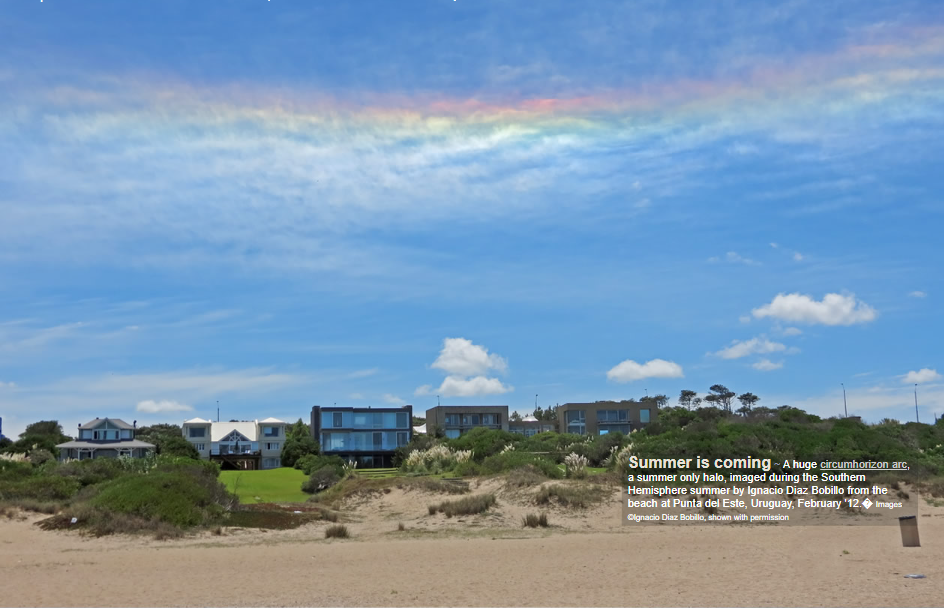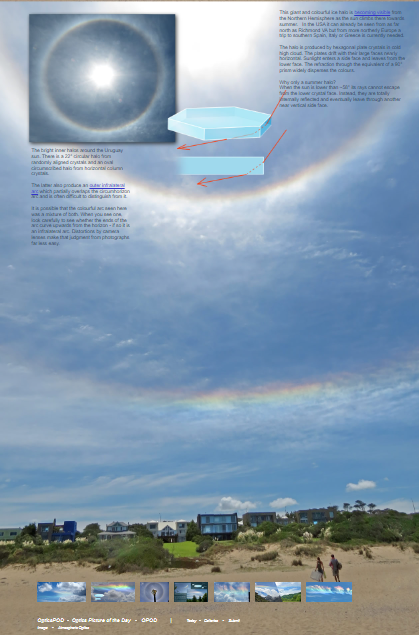OPOD - Summer Halo
OPOD - Summer Halo: A Spectacular Atmospheric Phenomenon
As the summer season approaches, nature unveils its stunning display of atmospheric optics, including the mesmerizing summer halo. This captivating phenomenon, captured in images taken by Ignacio Diaz Bobillo from Punta del Este, Uruguay in February '12, is a sight to behold. The vibrant colors and expansive shape of the halo make it a unique spectacle, visible only during the Southern Hemisphere summer. Let's delve into the intricacies of this fascinating atmospheric occurrence.
Unraveling the Elements of the Summer Halo
The summer halo comprises two distinct components that contribute to its awe-inspiring appearance. Firstly, there is the 22° circular halo, formed by randomly aligned ice crystals. These crystals scatter sunlight, creating a circular ring around the sun. Secondly, there is an oval circumscribed halo, produced by horizontal column-shaped ice crystals. These crystals not only generate the oval shape but also give rise to an outer infralateral arc, which partially overlaps with the circumhorizon arc.
Distinguishing the Circumhorizon Arc and the Infralateral Arc
Differentiating between the circumhorizon arc and the infralateral arc can be challenging due to their similar appearance. However, careful observation can help identify their distinguishing features. When viewing an arc, pay close attention to whether its ends curve upwards from the horizon. If they do, it is likely an infralateral arc. It is worth noting that photographs of these arcs can be distorted by camera lenses, making it more difficult to make accurate judgments.
The Summer Halo's Journey from Southern to Northern Hemisphere
As summer arrives in the Northern Hemisphere, the mesmerizing summer halo begins its journey northward. Already visible in locations such as Richmond, VA in the United States, this celestial phenomenon becomes increasingly prominent as the sun climbs higher in the sky. However, to witness the full glory of the summer halo, those residing in more northerly regions of Europe may need to venture south to destinations like southern Spain, Italy, or Greece.
Unveiling the Hexagonal Plate Crystals and Their Role
The summer halo owes its existence to hexagonal plate crystals present in cold high clouds. These crystals drift with their large faces positioned almost horizontally. When sunlight enters a side face of the crystal, it refracts and exits through the lower face. This refraction through the equivalent of a 90° prism disperses the colors widely, resulting in the vibrant hues that define the summer halo.
The Curious Case of the Summer-Exclusive Halo
One intriguing aspect of the summer halo is its exclusivity to the summer season. This peculiarity stems from the sun's position in relation to the crystal faces. When the sun is lower than approximately 58°, its rays cannot escape through the lower face of the crystal. Instead, they undergo total internal reflection within the crystal and eventually exit through another nearly vertical side face. This unique behavior restricts the formation of the summer halo to specific times of the year.
In conclusion, the summer halo is a breathtaking atmospheric phenomenon that graces the skies during the Southern Hemisphere summer. Composed of circular and oval halos created by ice crystals, this captivating display is a testament to nature's artistic flair. As the sun makes its journey towards the Northern Hemisphere, the summer halo gradually becomes visible in more northern regions. Its vibrant colors and unique formation make it a sight worth traveling for. So, keep your eyes on the sky and prepare to be enchanted by this remarkable celestial show.

Summer is coming ~ A huge circumhorizon arc, a summer only halo, imaged during the Southern Hemisphere summer by Ignacio Diaz Bobillo from the beach at Punta del Este, Uruguay, February '12.� Images ©Ignacio Diaz Bobillo, shown with permission

The bright inner halos around the Uruguay sun. There is a 22° circular halo from randomly aligned crystals and an oval circumscribed halo from horizontal column crystals.
The latter also produce an outer infralateral arc which partially overlaps the circumhorizon arc and is often difficult to distinguish from it.
It is possible that the colourful arc seen here was a mixture of both. When you see one, look carefully to see whether the ends of the arc curve upwards from the horizon - if so it is an infralateral arc. Distortions by camera lenses make that judgment from photographs far less easy.
This giant and colourful ice halo is becoming visible from the Northern Hemisphere as the sun climbs there towards summer. In the USA it can already be seen from as far north as Richmond VA but from more northerly Europe a trip to southern Spain, Italy or Greece is currently needed.
The halo is produced by hexagonal plate crystals in cold high cloud. The plates drift with their large faces nearly horizontal. Sunlight enters a side face and leaves from the lower face. The refraction through the equivalent of a 90° prism widely disperses the colours.
Why only a summer halo?
When the sun is lower than ~58° its rays cannot escape from the lower crystal face. Instead, they are totally internally reflected and eventually leave through another near vertical side face.

Note: this article has been automatically converted from the old site and may not appear as intended. You can find the original article here.
Reference Atmospheric Optics
If you use any of the definitions, information, or data presented on Atmospheric Optics, please copy the link or reference below to properly credit us as the reference source. Thank you!
-
<a href="https://atoptics.co.uk/blog/opod-summer-halo/">OPOD - Summer Halo</a>
-
"OPOD - Summer Halo". Atmospheric Optics. Accessed on November 26, 2024. https://atoptics.co.uk/blog/opod-summer-halo/.
-
"OPOD - Summer Halo". Atmospheric Optics, https://atoptics.co.uk/blog/opod-summer-halo/. Accessed 26 November, 2024
-
OPOD - Summer Halo. Atmospheric Optics. Retrieved from https://atoptics.co.uk/blog/opod-summer-halo/.